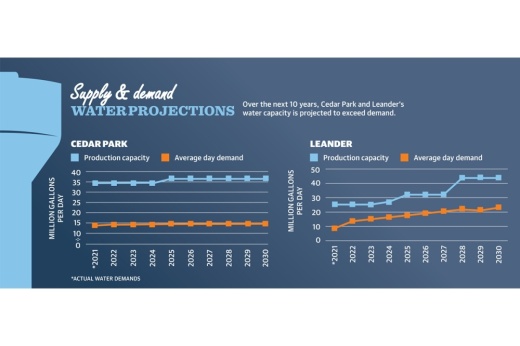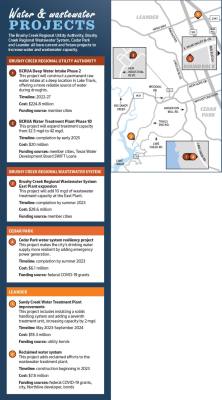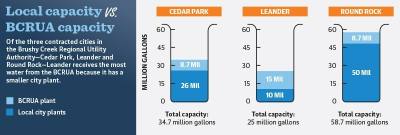Because of this, major projects are underway at local facilities to expand water and wastewater treatment systems to meet the needs of a growing population and address any potential access issues.
Leander Conservation Program Coordinator Bill Teeter, who was hired in July, encouraged residents to do their part to conserve water.
“We’ve got the drought in our face right now, so we’re dealing with trying to get people to conserve water now through indoor and outdoor means,” he said.
Supply and demand
The source of water for local municipalities varies. Leander utility customers mostly receive their water through the Brushy Creek Regional Utility Authority, a partnership among Leander, Cedar Park and Round Rock. Leander also produces water at its local plant, the Sandy Creek Regional Water Plant.
In Cedar Park, 75% of water capacity comes from the Cedar Park Water Treatment Plant, and 25% is from the BCRUA.
Of the three cities involved in the BCRUA, Leander uses the bulk of that water supply. However, this is because it has a significantly smaller local plant than both Cedar Park and Round Rock.
The BCRUA plant produces 32.5 million gallons per day. According to the governing contract, Leander has about 15.1 mgd available to use, while Cedar Park and Round Rock both have about 8.7 mgd.
Because Sandy Creek produces 10 mgd, Leander has a combined water capacity of about 25 mgd—well above the city’s average demand of 11.7 mgd from January to July. However, Leander Director of Public Works Gina Ellison said at the end of July and in early August, the city was using 18-19 mgd.
“Currently we’re using right around 78% of our treatment capacity, so we’re still doing pretty good,” Ellison said.
The city has plans to expand its water treatment capacity in the years to come, increasing capacity to 44 mgd in 2030, according to Leander data. Demand is projected to increase to 23.6 mgd by then.
Cedar Park has production capacity of 34.7 mgd and average demand of 14.59 mgd. Current demand peaks reach 28.72 mgd, according to Cedar Park data. By 2031, Cedar Park is projected have a production capacity of 37.2 mgd to meet an average demand of 15.61 mgd, with peaks reaching 30.71 mgd.
“We have ample capacity in our water systems for our full build-out of our population in Cedar Park,” Assistant City Manager Sam Roberts said. “We’ve spent years and years planning for that.”
Water conservation efforts
Teeter’s position is new for the city of Leander and will focus on efforts to manage water usage.
Cedar Park and Round Rock officials suggested Leander hire a conservation specialist, Leander Mayor Christine DeLisle said, because each of those cities has one who has helped them tremendously.
“This is all just an effort to get our usage down and manageable and make sure that we are showing our partners in BCRUA that we want to work with them; we want to be responsible; and we take our partnership seriously,” she said.
Teeter said landscape irrigation is the largest user of water, and roughly one-third of all water that enters the system is wasted. His main initiative is to educate residents, property owners and business owners on how to save water and irrigate more efficiently.
“It’s just bad scheduling, running stations too long, undetected breaks, blown heads, indirect pressure,” he said. “All those things add up to water waste through irrigation, so we’ll be working a lot on trying to teach people how to irrigate better.”
In Leander, commercial properties are using more water than residential properties, even though there are more residential water accounts, Ellison said. At the end of July, the city of Leander had 26,726 residential water accounts, 850 commercial accounts and 93 school accounts, according to city data.
During a typical summer month, data shows the average commercial customer uses three times as much water as a residential customer. Additionally, more than twice the amount of water is used in the summer compared to the winter, city officials said.
In Cedar Park, single-family homes are the largest users of the water, Roberts said. Looking ahead, the city of Cedar Park is not expecting a lot of new single-family housing developments, but additional commercial and retail developments are expected.
As of July, the city of Cedar Park had 21,861 residential water accounts—each using an average of 9,080 gallons of water per month—and 1,376 commercial accounts, according to city data.
Cedar Park is in Stage 2 of its conservation plan, Director of Public Works and Utilities Eric Rauschuber said. The city has been in this stage since 2015, after the last major drought ended. The city chose to remain in that stage because City Council felt it was the “good stewardship thing to do,” Roberts said.
Similar to Leander, the city of Cedar Park is working to tackle landscape irrigation, in which most of the water is used.
“About 50% of our summer water is used for irrigation,” Rauschuber said. “So our focus, where we move the needle the fastest, is you focus on the residents following [the watering schedule].”
Water and wastewater improvements
Cedar Park, Leander and the BCRUA have projects underway to improve and expand water systems.
Two BCRUA water projects are under construction: the Deep Water Intake Phase 2 and the Water Treatment Plant Phase 1D expansion.
The Phase 1D expansion project will add a fourth treatment structure, expanding treatment capacity from 32.5 mgd to 42 mgd.
BCRUA General Manager Karen Bondy said this project—which will be finished in early 2025—was prompted by Leander needing more capacity.
The intake project, which is anticipated to be completed in 2027, will provide a more reliable water supply during droughts, Bondy said.
Leander anticipates completing the design of the Sandy Creek Water Treatment Plant expansion in October. This project will replace undersized residual handling ponds and add a seventh treatment unit, increasing the plant’s treatment capacity by about 2 mgd.
Construction for Cedar Park’s water system resiliency project is in progress and is expected to be completed in summer 2023. This project will better protect the city’s drinking water system, city officials said.
Additionally, Leander officials have focused efforts on reclaimed water, which is treated wastewater that is safe and suitable for watering purposes. Design for Leander’s reclaimed water system project is 90% complete, and construction will begin in 2023. This project will reduce pressure on the city’s potable water supply, city officials said.
Cedar Park city staff has already put reclaimed water systems in place to help irrigate multiple areas throughout the city. The city’s reclaimed water systems irrigate one of Cedar Park’s largest sports parks, properties near facilities and all public works activities from cleaning sewer lines to street sweeping, Rauschuber said. City staff are discussing extending the practice to another large park.
With water projects and conservation efforts underway, officials in both cities urge everyone to do their part to conserve.
“It’s all of our responsibility to be stewards of our resources,” said Anne Duffy, Cedar Park council member and BCRUA president.
Brooke Sjoberg contributed to this report.








